Michael Swanwick's Blog, page 29
January 11, 2023
Henry Wessells' Wonderful January Sale
.

Over at Temporary Culture, my friend Henry Wessells is having a book sale of some 112 items marked down 25% from their usual prices. Two items caught my attention.
The first is my own Blue As the Moon. As fans of Dragonstairs Press (Marianne Porter, prop.) know, once in a blue moon--in fact, literally on the day of a blue moon--Marianne prints a limited edition of 69 copies of a chapbook created for the occasion up for sale. Then, at midnight, any unsold copies are burned in the wood stove.
This is Marianne's way of celebrating the transience of the printed word, of art, and of life itself.
Dragonstairs Press doesn't have much of a secondary market. Marianne makes the chapbooks and other items, they sell out, and people tend to hold onto them. So when an out-of-print item comes available, it's an occasion.
Blue As the Moon is being offered at $32, down from $40.
The other item is a hardcover copy of Hope Mirrlees' "lost masterpiece of modernism," Paris, a Poem, beautifully designed and letterset-printed by Pegana Press.
By my reckoning, this is the fourth time this poem has ever been printed. The first was as a chapbook that Virginia Wool printed on her tabletop press, back in the 1920s. The second was a bowdlerized (by Mirrlees herself) version in a mimeographed academic zine dedicated to Woolf. The third time, restored and explicated by Julia Briggs was in Bonnie Kime Scott's Gender in Modernism. So this is the second stand-alone version of the poem ever, and the first in hardcover.
Also, as I said, a beautiful book.
This item is being offered at $750, marked down from $1,000. Which at first blush looks expensive. But in fact it's a bargain. There are only two copies still available from Pegana and they cost $2,200 each. (Hand-crafted books of this caliber ain't cheap.)
You can find the entire catalog here. It's a fun thing to browse.
January 9, 2023
DUCKS by Kate Beaton
.
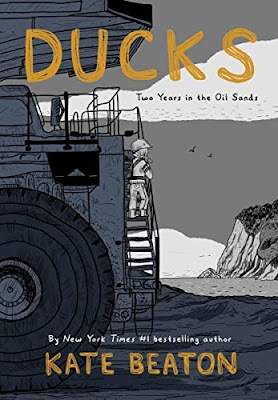
It's hard to sum up this book, but I'll begin by saying that along with Maus by Art Spiegelman, Fun Home by Alison Bechdel, and Watchmen by Alan Moore, it is quite possibly one of the four best graphic novels ever. This despite the fact that unlike the others it lacks a high concept.
Ducks is about the two years Kate Beaton spent in the oil sands of Alberta. The pay is good, particularly for a young woman from Cape Breton with college debts to pay off. But the conditions are dreadful, the work is draining, and as is inevitable where the male-to-female ratio is fifty to one, the misogyny is so thick you could cut it with a knife.
So it's strange that these situations produced a work so delicately nuanced, so observant of human behavior, and so generous in its characterizations (of men in particular) as this one.
Kate Benton is--or, very soon now, I must say was--best known for Hark! A Vagrant, whimsical Web cartoons that were usually based on history or literature, cheerfully skewed, and almost always Canadian-centric. One of my friends from North of the Border referred to her as "Canada's cultural secret weapon." When she gave up on producing free cartoons in order to create children's books, her freeloading readers, myself included, mourned.
And then came Ducks.
Beaton never mentions the word "capitalism," but in its straightforward portrayal of what it's like to perform demanding work that is simultaneously boring and dangerous simply because one has family to support, it's obviously the villain here. The book does not present itself as a coming of age narrative, yet young Kate starts out perfectly likeable and grows to be rather more admirable by the end. The loneliness, isolation, and suffering of those forced to work far from the comforts the rest of us enjoy are presented by Beaton not only without self-pity but with an explicit awareness that many of those around her had it even worse. Her judgements are all even-handed. This book has a large cast of characters and the same insight into its times and the lives of its people as your favorite nineteenth century novel.
And, just as I warned you at the beginning, I've failed to give you the last glimmer of its virtues. Buy it anyway.
You'll thank me.
And since you wonder . . .
The best-known Hark! A Vagrant cartoon (though not, oddly, about Canada) is Dude Watching With the Brontes. You can find it here.
Above: Yes, the cover makes it look boring. It's nothing of the sort.
*
January 6, 2023
A Young Photographer at the Mummers Parade
.

Marianne and I rented a room at the Bellevue last weekend so we could spend New Year's Eve at the Pen & Pencil Club with our cronies and New Year's Day watching the Mummers Parade. Staying in a hotel on Broad Street meant that we could watch the parade until we were cold and weary, then go inside to watch the parade on TV until we were warm and rested and then go out again. Repeating as often as necessary. (The Mummers Parade is over eight hours long.)
Partway through the day, we were watching the Mummers when a young photographer with one of those little cameras that take small Polaroid photographs asked Marianne, "May I take your picture?"
"Sure," Marianne said, so the girl did. Then she asked, "May I take another?"
This time I posed with Marianne. To our surprise, the young photographer then gave Marianne the photo. That's it up above.
It's a good photograph--well composed and visually interesting. Which is not a surprise, because her mother, who was there with her, was also a photographer and to judge from the camera she was carrying a serious one.
That's all. It's a small incident but for us a pleasant one. And a reminder of how pleasant it can be to encounter strangers out on the street
*
January 4, 2023
Suzy McKee Charnas Meets Her Ideal Reader
.
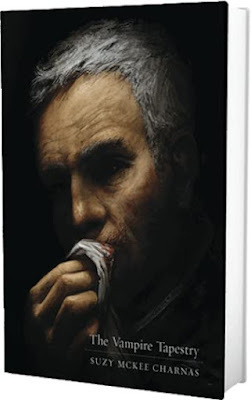
Word is out on social media that Suzy McKee Charnas is no longer with us. She was 83 years old, which is a good run, but it still feels like she died too young. She is possibly best known for Walk to the End of the World and its sequels, but my own personal favorite of her works is The Vampire Tapestry, a novel made up of a series of stories illuminating the inner life of Dr. Edward Weyland, vampire and professor of anthropology.
This is an elegant work, tough and sinewy, beautifully written, and marvelously well thought out. I would go into this in more detail but it's been years since I last reread it, and if I opened the book now I would fall into it, not to reappear for a week. It really is that good.
I met Ms. Charnas only once, back in the eighties, and I doubt I made much of an impression on her. But it's worth recounting because that was the time she first met Judith Moffett.
Judy Moffett began as a serious poet (I greatly admire her collection Whinny Moor Crossing, the title poem in particular), fell into science fiction almost by accident, and quickly became an intensely admired novelist and short fiction writer. She was and is one of those tough-minded, tolerate-no-nonsense, totally admirable women who find in genre a place where they can think and do exactly as they like. And she admired the hell out of Suzy McKee Charnas. Most particularly, as with me, for The Vampire Tapestry.
Judy's day job was as an academic at the University of Pennsylvania, where she taught, among other things, a science fiction class. As part of which, that year, the class did a reading of a script--I think written by Judy, but it's been a long time--of one of the component stories of the Tapestry. The protagonist was female but the student reading her lines was male.
Judy wrote to Suzy McKee Charnas telling her about the project and inviting her to come and witness an encore performance. An invitation which was readily accepted. Gregory Frost and I, being friends and local writers, were also invited.
Charnas was one of the people she most admired. And her appreciation of The Vampire Tapestry went beyond granular. I remember that she particularly appreciated the presentation of psychological analysis, how it's done and what it can and cannot achieve. As I recall it, she could easily have written a book extolling that novel's virtues. And every word of it would have been deserved. In many ways, Judy was its ideal reader.
So you can imagine how nervous she was at the prospect of meeting her hero. Judith Moffett was not the kind of woman who gets nervous. But this time she was.
And how did work out?
It was a beautiful day with fleecy clouds in a blue sky and sunshine everywhere when I strode across the Penn campus toward the rendezvous point. And there, walking toward me, came Judy and her good friend Suzy, engrossed in conversation and as thick as thieves.
"Judy!" I shouted and "Michael!" she cried, and we hugged (we were neither of us very huggy people but at that moment it seemed right) while Suzy McKee Charnas beamed at us.
It was a lovely moment and a perfect day and the memories of the rest of it are private to Judith Moffett. But, clearly, Suzy McKee Charnas thought almost as highly of Judy as Judy did of her.
And that's all. I just thought you might want to know that.
Above: The brooding and appropriate book cover is of the Centipede Press edition of The Vampire Tapestry.
*
December 27, 2022
S is For Story ("The Sorcerer's Daughter")
.

This seems to be a season for me to post flash fiction! I'm almost at a loss as to how to explain how this story came about. It involved Eileen Gunn, of course. Anything involving Eileen and fiction leaves me feeling addle-brained and confused.
So anyway. Over on Facebook, I somehow got involved in a conversation with the esteemed Ms. Gunn, and it somehow ended in a fiction duel. She was to write a short-short beginning with slapstick and ending with tragedy and I was to write one beginning in tragedy and ending in slapstick. In one day.
Simple, yes? Only Eileen somehow got the assignment turned around and wrote a story beginning darkly and ending in slapstick. So, after posting the first story, which began dark and ended light, I posted a second, which began light and ended dark. All in the prescribed day.
Oh, and for some reason the phrase "Gnomes begone!" was supposed to appear in each story. I can't explain this. Just thinking about it leaves me feeling addle-brained and confused.
The only problem was that Eileen wrote a good story and I wrote two terrible ones. So I picked the one with the opposite overall shape of hers and rewrote it. The first version, I regret to say, involved a lot of goose droppings. Those were the first thing to go away. Also, as long as I was revising the story, I figured I might as well create a history for the fantasy world it occurred within. So I did.
And now I have a story that starts out light and silly and ends up dark and despairing. I cannot explain why it was thought this would be a good idea. Just trying to do so makes me feel confused and... and the other thing.
Anyway, here it is, the distinguished thing:
The Sorcerer’s Daughter
by
Michael Swanwick
Why was her life such a mess? Why did her spells always go wrong? Tisane’s father said she was as naturally powerful as anyone he had ever known—more so even than her late mother, who had been the wonder of the world—but impulsive. “You will be allowed to spell-cast without adult supervision when you’ve mastered calculus and not a minute before.” But she had barely begun learning algebra and already she was fourteen. At this rate, she’d be an old hag before she got to do anything neat.
Thinking dark thoughts, Tisane lugged a bucket of milk fresh-squeezed from their milch cow toward the cheese cave her father had excavated with one magisterial wave of his hand.
Harrawnk! Startled by who knew what, one of the geese hysterically half-flew half-ran past Tisane and into the barn, whose door she had accidentally left open. With a sigh, she put down the bucket and went after the silly thing.
Inside, the goose had somehow flapped and struggled its way up onto a high shelf, far beyond Tisane’s reach. In its panic, it had gotten lodged among the assortment of ancient machines from the Age of Science, which her father always meant to get around to examining someday. Honking bitterly, it endlessly bemoaned its plight.
Well, Tisane thought. Here was a good opportunity to try out her theory that magic was chiefly a matter of confidence. Her father was taking his mid-afternoon nap and wouldn’t enjoy being awakened for so small a matter. So she’d save him the inconvenience. Cocking her wrists and wriggling her fingers witchily, she shouted, “Down from the shelf, you goose!”
Poof! Small, soft feathers exploded into the air. (Tisane inhaled one and almost choked before she managed to cough it free.) Out from the center of that white cloud flew the bedraggled-looking goose. Riding atop it, thin legs closed about its neck was a laughing, red-capped elf.
“Fool!” the elf gloated. “I am your doom! I will unstitch your sacks of flour and topple your buckets of milk!” He flew the goose straight at Tisane. If she hadn’t ducked, it would have slammed into her face.
Gathering up her skirts, she ran after the airborne prankster out of the barn.
“What’s all this foofaraw?” Tisane’s father came lumbering out of their cottage, face red with annoyance.
“Don’t worry, honored sire, I’ve got everything under control.” Once again, Tisane assumed the stance of a sorceress. Confidence! she reminded herself. Grabbing words at random from her reading, she intoned in the most self-assured and commanding voice imaginable, “Double, double, toil and trouble! Gnomes begone!”
Then, turning to her father with a bright confident smile, “See? Now they’re someone else’s problem.”
“But the great sorcerer’s expression, his horror-struck eyes in particular, made her wonder if maybe she’d gotten the spell wrong. Just a smidgeon, anyway. “By the demons of Old Detroit!” he cried. “You’ve created a von Neumann recursion!”
Tisane turned back. There were two elf-and-goose combinations in the sky.
Then four.
Then eight.
The elves were laughing maniacally. Waving their little red caps in the air, they dive-bombed the milk bucket, the geese, the chickens, the watchdog… even the milch-cow, which they sent scampering through the gooseberry bushes and bucking and kicking across the herb garden.
“Bring me my staff of power!” Tisane’s father commanded and she ran to fetch it. The staff had once been a nuclear control rod before it was transformed in the forges of the First Mages, back when the old world fell and science was transformed into magic.
By the time Tisane got back, the sky was dark with geese and the world echoed with the malicious laughter of the elves. Holding his staff before him, the mighty sorcerer strode forward—
And stepped on the toppled bucket of milk. He fell backward and struck his head on the hardened dirt barnyard. Tisane ran to him and raised his head, but he was out cold.
Meanwhile, the geese and elves continued to multiply. The sky darkened and the sun dimmed. Tisane’s father had always said that elves were nothing but conceptual machines, no more alive than the legendary computers of yore. She had always wondered what he meant by that. Now she thought she could understand just a glimmer. But not enough to do anything with it.
She had power enough within her to accomplish anything. But she didn’t know how to use it. Her algebra was weak and her calculus nonexistent.
The last sliver of sun disappeared behind overlapping layers of wings. Darkness swallowed up the world. The laughter of the elves merged and became universal, the roaring surf of an ocean of madness.
Tisane managed to drag her father inside the cottage and lay him on his feather bed. Then she lit a candle. Outside, the air was filling with the bodies of elves and geese, as tightly packed as the birds in the print made by the Wizard Escher that hung on the wall in her father’s study. They were so tightly thronged that they could no longer move. Still, they kept multiplying. Tisane could feel it. She had the power in her and it responded to the presence of anything magical.
Her last thought before the windows exploded inward was: It’s not fair.
Not long after, the total mass of elves and geese became greater than the Chandrasekhar limit, and the entire world collapsed into a black hole. But by then, there was nobody around to marvel at how tidily it had all come about.
*
@font-face {font-family:"MS Mincho"; panose-1:2 2 6 9 4 2 5 8 3 4; mso-font-alt:"_l_r __f_"; mso-font-charset:128; mso-generic-font-family:modern; mso-font-pitch:fixed; mso-font-signature:-536870145 1791491579 134217746 0 131231 0;}@font-face {font-family:SimSun; panose-1:2 1 6 0 3 1 1 1 1 1; mso-font-alt:____; mso-font-charset:134; mso-generic-font-family:auto; mso-font-pitch:variable; mso-font-signature:3 680460288 22 0 262145 0;}@font-face {font-family:"Cambria Math"; panose-1:2 4 5 3 5 4 6 3 2 4; mso-font-charset:0; mso-generic-font-family:roman; mso-font-pitch:variable; mso-font-signature:-536870145 1107305727 0 0 415 0;}@font-face {font-family:"\@MS Mincho"; panose-1:2 2 6 9 4 2 5 8 3 4; mso-font-charset:128; mso-generic-font-family:modern; mso-font-pitch:fixed; mso-font-signature:-536870145 1791491579 134217746 0 131231 0;}@font-face {font-family:"\@SimSun"; panose-1:2 1 6 0 3 1 1 1 1 1; mso-font-charset:134; mso-generic-font-family:auto; mso-font-pitch:variable; mso-font-signature:3 680460288 22 0 262145 0;}p.MsoNormal, li.MsoNormal, div.MsoNormal {mso-style-unhide:no; mso-style-qformat:yes; mso-style-parent:""; margin:0in; mso-pagination:none; mso-hyphenate:none; text-autospace:ideograph-other; font-size:12.0pt; font-family:"Times New Roman",serif; mso-fareast-font-family:SimSun; mso-bidi-font-family:Arial; mso-font-kerning:1.5pt; mso-fareast-language:ZH-CN; mso-bidi-language:HI;}.MsoChpDefault {mso-style-type:export-only; mso-default-props:yes; mso-fareast-font-family:SimSun; mso-font-kerning:1.5pt; mso-fareast-language:ZH-CN;}.MsoPapDefault {mso-style-type:export-only; mso-pagination:none;}div.WordSection1 {page:WordSection1;}
December 26, 2022
Moby Dick in 12 Words--With Plushie Toy Illustrations!
.
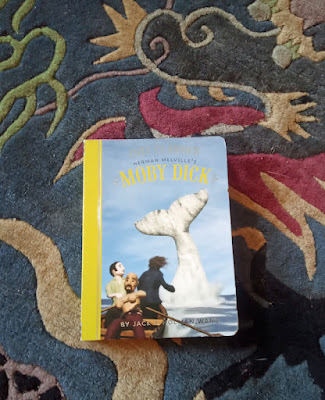
Look what I found in the dollar store! It's the Cozy Classics Moby Dick. As the back copy explains:
Teach your child simple words, concepts and stories--and an appreciation of the classics! In each book, twelve adorable needle-felted scenes and twelve child-friendly words capture hte essence of a beloved masterpiece.
Here's the passage explaining the conflict at the heart of this classic work:
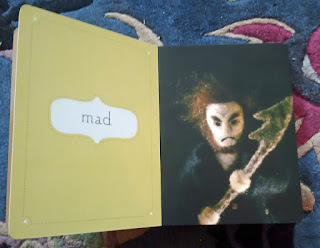
And here's the moving ending:
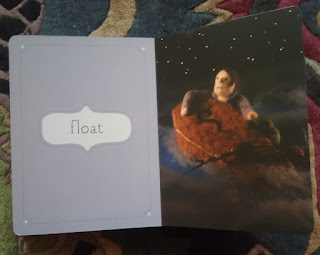
Which I believe nobly sums up the novel's Epilogue:
"AND I ONLY AM ESCAPED ALONE TO TELL THEE" Job.
The drama's done. Why then here does any one step forth?- Because one did survive the wreck.
It so chanced, that after the Parsee's disappearance, I was he whom the Fates ordained to take the place of Ahab's bowsman, when that bowsman assumed the vacant post; the same, who, when on the last day the three men were tossed from out of the rocking boat, was dropped astern. So, floating on the margin of the ensuing scene, and in full sight of it, when the halfspent suction of the sunk ship reached me, I was then, but slowly, drawn towards the closing vortex. When I reached it, it had subsided to a creamy pool. Round and round, then, and ever contracting towards the button-like black bubble at the axis of that slowly wheeling circle, like another Ixion I did revolve. Till, gaining that vital centre, the black bubble upward burst; and now, liberated by reason of its cunning spring, and, owing to its great buoyancy, rising with great force, the coffin life-buoy shot lengthwise from the sea, fell over, and floated by my side. Buoyed up by that coffin, for almost one whole day and night, I floated on a soft and dirgelike main. The unharming sharks, they glided by as if with padlocks on their mouths; the savage sea-hawks sailed with sheathed beaks. On the second day, a sail drew near, nearer, and picked me up at last. It was the devious-cruising Rachel, that in her retracing search after her missing children, only found another orphan.
There are also adaptations of Great Expectations, Pride & Prejudice, War & Peace, and the first three Star Wars movies. All of them exactly twelve words long. You can learn more about Cozy Classics by clicking here.
*
December 24, 2022
Manger Animals
.
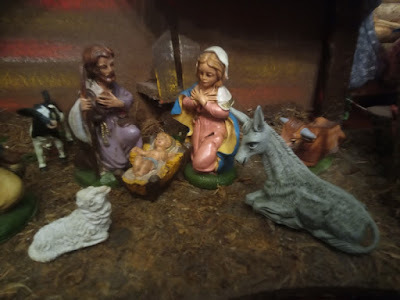
Merry Christmas, everybody! My present for you is a story I wrote a decade ago, titled...
Manger Animals
There is a legend that on Christmas Eve the animals can talk. Yet of all the many animals you’ve known or owned, be they pets or next-door dogs or half-tame squirrels that you almost got to accept a peanut out of your hand once, none have ever done remotely anything like that.
Still, the legend is true. It just doesn’t apply to all animals. It applies only to those who were in one specific manger on the outskirts of Bethlehem two thousand something years ago. These were all made immortal by the Infant Jesus who, like any other child, had an inordinate fondness for dumb beasts. And for 364 days of the year (365 on leap years) they’re dumb in both senses of the word.
Ahhh, but on Christmas Eve...
On Christmas Eve, the cow and the donkey and the little goat that gnawed on Baby Jesus’s blanket are given the gift of speech. As are the two lambs who wandered in looking for fodder, the camels who carried the magi to the event and then stuck their noses in the window to see what was going on, and the pigeons who fluttered in the rafters while Joseph muttered angrily about their droppings.
“It was a night much like this one . . .” the cow begins.
“No, quieter,” says a camel. “There weren’t so many cars back then.”
“It was cold outside,” says a lamb. “But I found a warm spot to sleep right over there.”
“I gnawed on a blanket,” says the goat proudly. “But somebody yanked it away.”
“I wonder who?” murmurs a dove. For animals have very little sense of what is and is not important, once you move away from the compelling subjects of food and sleep. The fact that there were people present two thousand years ago is almost forgotten. Who those people might have been is entirely beyond their ken.
Still, like any other old-timers, they do enjoy reminiscing.
“They don’t make oats the way they used to,” says the donkey. “And that’s a fact.”
*
@font-face {font-family:"Cambria Math"; panose-1:2 4 5 3 5 4 6 3 2 4; mso-font-charset:0; mso-generic-font-family:roman; mso-font-pitch:variable; mso-font-signature:3 0 0 0 1 0;}@font-face {font-family:Calibri; panose-1:2 15 5 2 2 2 4 3 2 4; mso-font-charset:0; mso-generic-font-family:swiss; mso-font-pitch:variable; mso-font-signature:-536859905 -1073732485 9 0 511 0;}p.MsoNormal, li.MsoNormal, div.MsoNormal {mso-style-unhide:no; mso-style-qformat:yes; mso-style-parent:""; margin:0in; mso-pagination:widow-orphan; font-size:12.0pt; font-family:"Calibri",sans-serif; mso-ascii-font-family:Calibri; mso-ascii-theme-font:minor-latin; mso-fareast-font-family:Calibri; mso-fareast-theme-font:minor-latin; mso-hansi-font-family:Calibri; mso-hansi-theme-font:minor-latin; mso-bidi-font-family:"Times New Roman"; mso-bidi-theme-font:minor-bidi;}.MsoChpDefault {mso-style-type:export-only; mso-default-props:yes; font-family:"Calibri",sans-serif; mso-ascii-font-family:Calibri; mso-ascii-theme-font:minor-latin; mso-fareast-font-family:Calibri; mso-fareast-theme-font:minor-latin; mso-hansi-font-family:Calibri; mso-hansi-theme-font:minor-latin; mso-bidi-font-family:"Times New Roman"; mso-bidi-theme-font:minor-bidi;}div.WordSection1 {page:WordSection1;}
December 23, 2022
The Parable of the Creche
.
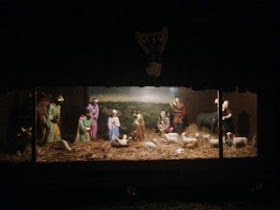
Once a year I present this story here on my blog. Sometimes the details differ by a word or three. But the message, I think, is timeless. Come gather around me, children, and I will tell you...
The Parable of the Creche
When first I came to Roxborough, forty-some ago, the creche was already a tradition of long standing. Every year it appeared in Gorgas Park during the Christmas season. It wasn't all that big—maybe seven feet high at its tip—and it wasn't very fancy. The figures of Joseph and Mary, the Christ Child, the three magi, the shepherds, and the animals were a couple of feet high at best, and there were sheets of Plexiglas over the front of the wooden construction to keep people from walking off with them. But there was a painted backdrop of the hills of Bethlehem at night, the floor was strewn was real straw, and it was genuinely loved.
It was a common sight to see people standing before the creche, especially in the evening, admiring it. Sometimes parents brought their small children to see it for the first time and the wonder they displayed was genuinely moving. It provided a welcome touch of seasonality and community to the park.
Alas, Gorgas Park is public property, and it was only a matter of time before somebody complained that the creche violated the principle of the separation of church and state. When the complaint finally came, the creche was taken out of the park and put into storage.
People were upset of course. Nobody liked seeing a beloved tradition disappear. There was a certain amount of grumbling and disgruntlement. One might even say disgrumblement.
So the kindly people of Leverington Presbyterian Church, located just across the street from the park, stepped in. They adopted the creche and put it up on the yard in front of their church, where it could be seen and enjoyed by all.
But did this make us happy? It did not. The creche was just not the same located in front of a church. It seemed lessened, in some strange way, made into a prop for the Presbyterians. You don't see people standing before it anymore.
I was in a local tappie shortly after the adoption and heard one of the barflies holding forth on this very subject:
"The god-damned Christians," he said, "have hijacked Christmas."
Above: The creche as it stands now. Personally, I'm grateful to the Presbyterians for rescuing it.
*
@font-face {font-family:"Cambria Math"; panose-1:2 4 5 3 5 4 6 3 2 4; mso-font-charset:0; mso-generic-font-family:roman; mso-font-pitch:variable; mso-font-signature:3 0 0 0 1 0;}@font-face {font-family:Calibri; panose-1:2 15 5 2 2 2 4 3 2 4; mso-font-charset:0; mso-generic-font-family:swiss; mso-font-pitch:variable; mso-font-signature:-536859905 -1073732485 9 0 511 0;}p.MsoNormal, li.MsoNormal, div.MsoNormal {mso-style-unhide:no; mso-style-qformat:yes; mso-style-parent:""; margin:0in; mso-pagination:widow-orphan; font-size:12.0pt; font-family:"Calibri",sans-serif; mso-ascii-font-family:Calibri; mso-ascii-theme-font:minor-latin; mso-fareast-font-family:Calibri; mso-fareast-theme-font:minor-latin; mso-hansi-font-family:Calibri; mso-hansi-theme-font:minor-latin; mso-bidi-font-family:"Times New Roman"; mso-bidi-theme-font:minor-bidi;}.MsoChpDefault {mso-style-type:export-only; mso-default-props:yes; font-family:"Calibri",sans-serif; mso-ascii-font-family:Calibri; mso-ascii-theme-font:minor-latin; mso-fareast-font-family:Calibri; mso-fareast-theme-font:minor-latin; mso-hansi-font-family:Calibri; mso-hansi-theme-font:minor-latin; mso-bidi-font-family:"Times New Roman"; mso-bidi-theme-font:minor-bidi;}div.WordSection1 {page:WordSection1;}
December 19, 2022
Samuel R. Delany on Thomas M. Disch
.
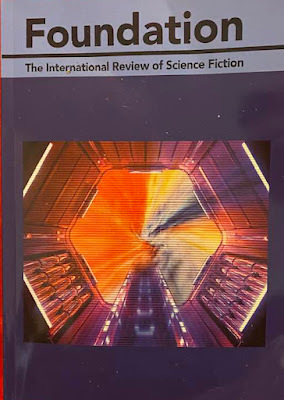
My interview with Samuel R. Delany on Thomas M. Disch, who was for many years this friend and then, abruptly, not, appears in the current issue of Foundation.
Here's how it came about. Chip was at a party at Marianne's and my house after Philcon, and started telling stories about Tom Disch, his brilliance, and his difficult personality. He had his listeners rapt. Gee, I thought. Somebody should get this stuff down on the record.
In my family, we have a saying, swiped from an R. A. Lafferty story--"You see your duty quickly, citizen." Whoever observes that "somebody" should do something is that somebody.
So Marianne and I invited Chip back for lunch and an interview. It covered a lot of interesting ground and a lightly edited version appears in Foundation under the title, 'Bitter, Fun and Bright': Samuel R. Delany on Thomas M. Disch. Here's one small taste:
The last time I went to Europe, I had gotten all the way to Istanbul. I found Istanbul a really great city. I told Tom what a wonderful, rich city it was. Of course it has a literary history. Things like in Hemingway's “The Snows of Kilimanjaro,” all the city sections take place in Istanbul—not to mention the opening of Christie’s Murder on the Orient Express (1934). Although that was not the social level of Istanbul I saw, I still always felt that that was something going on around me. (And, yes, the food was much, much better: Greek food, yes, but served in tiny amounts, like dim sum, so that it made culinary sense.) I had met people and I'd had fun while I was there. I'd had a great time.
Tom had a miserable time, I later found out.
The result was one of his best stories, called “The Asian Shore.” It's all about a totally isolated guy. Tom ended up spending like six weeks there during which he was not able to meet anyone. It produced things like “The Roaches.” Which is one of his best stories, about what happens when the bomb falls and you're thousands of miles away from anything you know. Also “The Asian Shore,” which is very basically a study of racism. Although that's not what you think when you first read it. John Benedict Harris, this architect, is being absorbed by the city and finally becomes indistinguishable from one of the Asians. This woman keeps calling him by the name Yavuz and his name is not Yavuz, but John Benedict Harris. You couldn’t have a more American name than that.
Tom thought his stay in Asia in Istanbul was the loneliest and most isolated time he ever had. On the one hand I feel good because it produced a great story. But Tom himself said he hated the experience.
You can find more information about Foundation here. If you want to subscribe or buy a single issue, you can do so here.
*
@font-face {font-family:"Cambria Math"; panose-1:2 4 5 3 5 4 6 3 2 4; mso-font-charset:0; mso-generic-font-family:roman; mso-font-pitch:variable; mso-font-signature:-536870145 1107305727 0 0 415 0;}p.MsoNormal, li.MsoNormal, div.MsoNormal {mso-style-unhide:no; mso-style-qformat:yes; mso-style-parent:""; margin:0in; mso-pagination:widow-orphan; font-size:12.0pt; font-family:"Times New Roman",serif; mso-fareast-font-family:"Times New Roman";}.MsoChpDefault {mso-style-type:export-only; mso-default-props:yes; font-family:"Calibri",sans-serif; mso-ascii-font-family:Calibri; mso-ascii-theme-font:minor-latin; mso-fareast-font-family:Calibri; mso-fareast-theme-font:minor-latin; mso-hansi-font-family:Calibri; mso-hansi-theme-font:minor-latin; mso-bidi-font-family:"Times New Roman"; mso-bidi-theme-font:minor-bidi;}div.WordSection1 {page:WordSection1;}
December 13, 2022
A Chatbot Reviews My Iron Dragon Trilogy
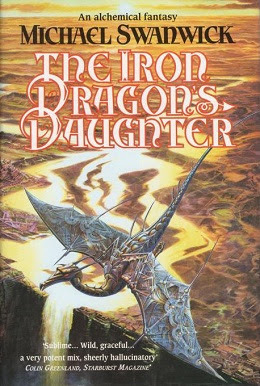
So out of idle curiosity I asked a Chatbot to write an essay on my Iron Dragon trilogy. The results below are hilarious if you know my work. (If you don't, reading The Iron Dragon's Daughter and either "The Dog Said Bow-Wow" or one of my Darger & Surplus novels will bring you up to speed.)
Oh, and I should mention that the final paragraph seems to be boilerplate whenever the chatbot is summing up a fantasy/sf novel.
Here it is, straight from the mouth of the machine:
The Iron Dragon novels by Michael Swanwick are a series of fantasy books that follow the adventures of a young boy named Darger and his loyal sidekick, Surplus, as they journey through a world filled with incredible technology and ancient magic.
The first book in the series, The Dragons of Babel, introduces us to Darger and Surplus as they are forced to flee their home in search of a better life. Along the way, they encounter a wide range of fascinating characters, including a powerful dragon named Babd Catha, who becomes their unlikely ally.
As they journey through this strange new world, Darger and Surplus must rely on their wits and cunning to survive. They are constantly confronted with danger and adversity, but they never give up hope and always find a way to overcome the odds.
Throughout the series, we see Darger and Surplus grow and mature, as they learn to harness their unique abilities and work together to overcome the challenges they face. In the end, they emerge as true heroes, ready to take on any challenge that comes their way.
The Iron Dragon novels are a thrilling and exciting read, full of adventure, magic, and a cast of memorable characters. Michael Swanwick's writing is sharp and engaging, and he has created a truly unique and captivating world for readers to explore. If you enjoy fantasy novels with a touch of technology and a lot of heart, then the Iron Dragon series is definitely worth checking out.
And the lesson we should learn from this is . . .
Laughing at the Chatbot is almost as much fun as marveling at all the AI programs that are industriously at work putting illustrators out of business. But they're just at the dawn of their powers and there are programmers working feverishly to improve them. Writers--including unpublished writers who are working hard to make the leap--should give some serious thought to how to respond to artificial fiction.
There isn't much time, though. So think fast.
*
Michael Swanwick's Blog
- Michael Swanwick's profile
- 546 followers



